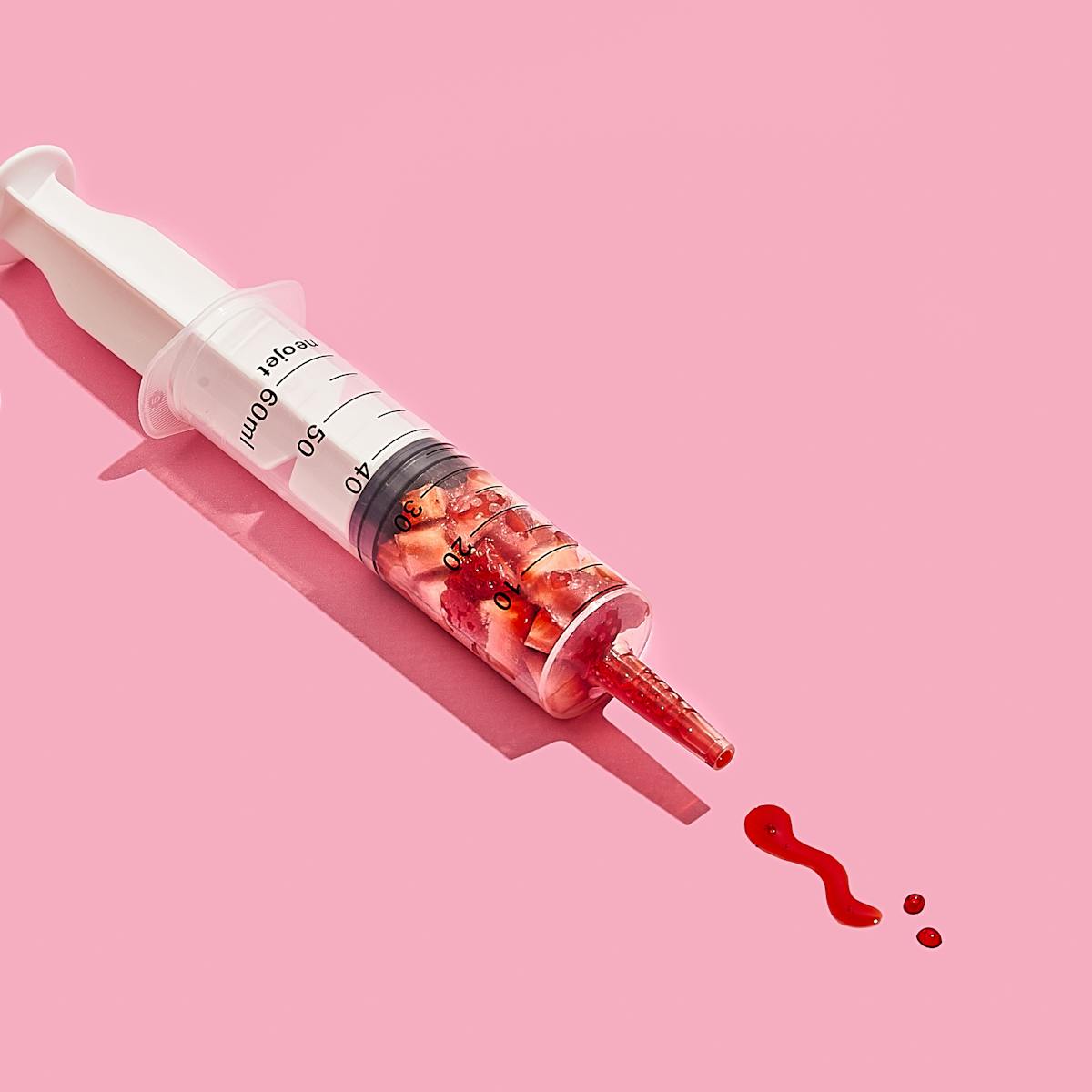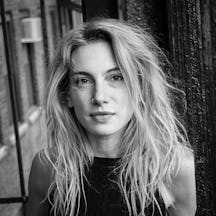As she reads a food diary written by a long-dead Renaissance artist, Virginia Hartley succumbs to a severe headache. On reflection, she speculates that the diary author’s distress, ostensibly kept in check through his orderly entries, might have transferred itself directly to her body, reminding her of the elisions of her own eating-disorder food diary.
The food diary and the power of unhealth
Words by Virginia Hartleyartwork by Anna Keville Joyceaverage reading time 8 minutes
- Article

Some years ago, I tried to keep a food diary and failed. I began it while I was an outpatient in an eating disorder service and continued (inconsistently) to keep it for several years. From the beginning, the relationship was difficult: I experienced the diary’s demands as so severe that I couldn’t bear to present it with the reality of my body, but at the same time was too frightened by its injunction to truthfulness to falsify my entries.
As a result, my diary was often simply silent: a kind of appalled speechlessness. It appears to exist only on an intake of breakfasts over years. The rest of the day appears to pass in blank starvation, but in truth in a way of eating which the diary must never know. As a treatment for an illness, it failed. Today, it has become a loose kind of notebook, and the body that took shape there is decomposed.
This experience suggested how the food diary is not the same as other diaries. That a food diary can fail, in the sense of not work – perhaps not something a journal can ever do – is one thought to begin with. Recently, I encountered the food diary of the Renaissance Mannerist painter Jacopo Pontormo (1494–1557) and this thought returned to me. Pontormo’s diary was kept over the last three years of his life while he worked on the frescoes (now lost) for the Basilica of San Lorenzo in Florence.
Food diaries, unlike journals, are not preserved for a reason: they have a finite and functional, often medical purpose, as a diagnostic tool, treatment programme or intervention. Anything from food intolerance to eating disorder may be investigated in their entries. And like any other body laid out on a white sheet for investigation, the food diary is a body of work without a mind: should it awaken and intervene, shock the food diary into a journal, then its form and function is suddenly in danger.
As such, the inner life of the food diary is, in its strictest sense, purely a digestive one. I did not think to imagine with mine; its audience remained limited and confidential. That Pontormo’s diary has survived centuries is unusual, and most likely has done so for the ways that it is at times in excess of food diary: as a kernel concealed in other more consumable identities. It is mostly read as an art-historical document which bears witness to the more ideal bodies being described alongside its process, on the chapel wall.

“My food diary was often simply silent: a kind of appalled speechlessness. It appears to exist only on an intake of breakfasts over years.”
The communications of the unwell body
The original diary is preserved within a large codex at the National Central Library, Florence; the volume I am reading one afternoon is the 1982 translation of the American visual artist, Rosemary Mayer. Its pages record daily intake: “I ate at home 30oz of bread, eggs, butter, and other things,” and also output: “two solid turds, looking like long wicks of cotton batting, like white fat”.
Such entries describe the page as a kind of non-continuous boundary or skin, which feeds and excretes and also – secretly, somewhere beneath that surface – digests: Pontormo’s attempt to break down what is going on in his body beyond the page. That body would succumb to illness three years after the diary is begun: an ending that can shed light on its beginnings. Pontormo may have kept his diary for the same reasons that food diaries are kept today: in fear of the disorderly communications of an unwell body, and out of desire to diagnose and make them meaningful.
By contemporary account, Pontormo died of “a dropsy”, an amorphous and now extinct disease diagnosis that reminds me how obscure the body was at the time. Dropsy might mean anything (heart failure, renal failure) but its symptoms are mostly described as a swelling of the body due to a build-up of fluid and the body’s inability to rid itself of its waste: “and also it sometimes happens that I feel full after eating… so that I feel bloated: that’s the time to be careful because it is health in excess.”
Pontormo may have kept his diary for the same reasons that food diaries are kept today: in fear of the disorderly communications of an unwell body, and out of desire to diagnose and make them meaningful.
While the diary mostly invokes a regimen of eating that defends against the possibility of that excess (and uses expressions of guilt to undo it when it does happen), something of the symptomatology seeps in. Marginal sketches of body parts distort and bloat the page; visually stretching the boundaries of the textual body and enacting a kind of digestive process whereby words are broken down into image – but which nevertheless remain stuck, unable to escape the page.
Pontormo’s death takes place suddenly in the unwritten space following his final meal entry. I think this should alert me to something – a silent presence, which I realise may have been communicating with me all along. This is this body which is ultimately not cured – which has refused the diary and its compositional process towards a more orderly, textual body – and which finally triumphs. In doing so, it kills the diary.

“While the diary mostly invokes a regimen of eating that defends against the possibility of that excess, something of the symptomatology seeps in.”
The food diary’s unconscious
Although the diary was written 500 years ago, it feels personal. I re-encounter in its pages a familiar struggle: between the food diary’s project to manage my body and my body’s resistance to this. Pontormo’s repetitive, limiting meal entries (bread, meat, eggs, borage salad) attempt to contain disturbance within a minimal margin for error, but ingeniously, disorder makes itself felt.
While I am here in the library with the diary, I develop a splitting headache. It has become difficult for me to take in the simple sentences I am reading when, without warning, the lights of the reading room cut out and plunge me into a deep gloom. A librarian arrives to advise that a campus-wide power cut has occurred.
I realise I am glad that I had no choice, that it was not my fault that I must distance myself from the diary. As I exit the library, my sensation is one of escape. Only then do I realise how unhealthy I feel.
Later, when I think about the ways that the diary has made me feel unwell – the wider campus electrical system too – I think how my headache and sensation of unhealth may also be kind of communication from the silent body. I think of this body as the food diary’s unconscious: the knowledge it tries to suppress with its numbing, heavy sequence of repetitive, carb-heavy entries, but which may have nevertheless leaked into me, making me feel ill.
I think of my headache as both a defence – my attempt to stop what is unpleasant and which may be dangerous from crossing a psychic barrier – but also a representation of what might have been communicated here, across the gap of 500 years: the inability to conceptualise and think about the prospect of death, the paralysing fear and terror, the sensation of not understanding. Did the real experience of Pontormo’s sick body find a way to make itself known and, bypassing my conscious mind, make contact first with my body?

“Food diaries fail in a way that other diaries do not because they set out to treat something.”
Psychoanalysis, another, if very different, language cure, is interested in the communication phenomenon known as the transference, the unconscious and often unspoken communication of the patient to their analyst, which the analyst may first register in their body. When the analyst is attuned to it, it represents a powerful treatment tool, whose astute interpretation can set the analysis on the right path; when it is missed or misunderstood, perhaps because the analyst is misled by the patient’s words, it can bring about the failure of the analysis.
My registering of the food diary’s unconscious – if that was it – was in this case of little use to it or to the long-dead Pontormo. But it may have been of use to me.
The power of the non-verbal
Food diaries fail in a way that other diaries do not because they set out to treat something. The failure of Pontormo’s diary and of mine is their failure to ultimately contain that more insistent communication of unhealth; the unwritten body within the written one. In Pontormo’s case, it was death that destroyed the diary and asserted the power of the non-verbal, which had been there all along.
In my case, it was illness, which, under cover of health, subtly changed what had been a healthy project to an unhealthy one in the pursuit of making me smaller. Both diaries ultimately refused the demands of health, but also resisted some of the more unhealthy features of food-diary writing – its moral dimension, aspirations to conformity, use of surveillance and shame – and ultimately expressed something of the impulse of the body.
This might be called the power of unhealth, and the disturbing paradox remains that in what these two diaries sacrifice in medical outcome, they gain conceptually and interpretively. In many ways this is a poor sacrifice. No doctor would say to me, “Never mind that your diary failed, because it is so interesting to read.” But these days, when I read it, rather in the way that I might do a ‘real’ diary, I think I understand something more of myself there and which might, in the longer term, keep me well.
About the contributors
Virginia Hartley
Virginia Hartley is based in London. Her short fiction has appeared in the Dublin Review and in Ambit; her non-fiction was recently anthologised in the essay collection ‘London Feeds Itself’ (Open City, edited by Jonathan Nunn) and is forthcoming elsewhere this autumn.
Anna Keville Joyce
Anna Keville Joyce, Food Artist and Creative Director, is originally from the USA and currently based out of Buenos Aires, Argentina, and New York City. With a background in food styling, design and anthropology, Anna has participated in a wide variety of photography, film, and installation projects worldwide, and has been featured in numerous publications and exhibitions. Her creative spark, attention to detail, and keen sense of composition has allowed her to gain a broad international client and she has the pleasure of collaborating on increasingly creative and dynamic projects.

